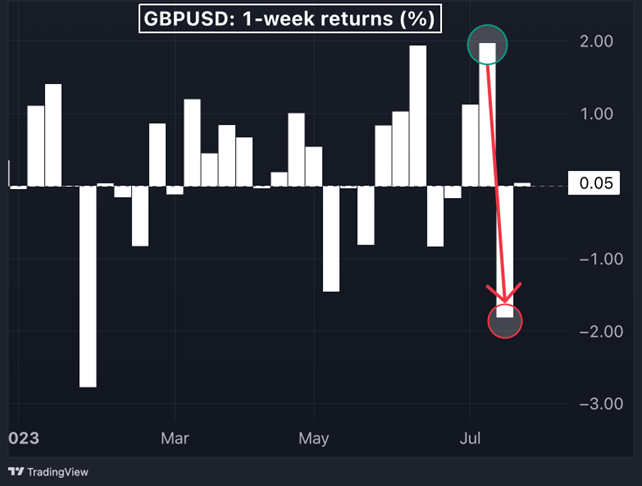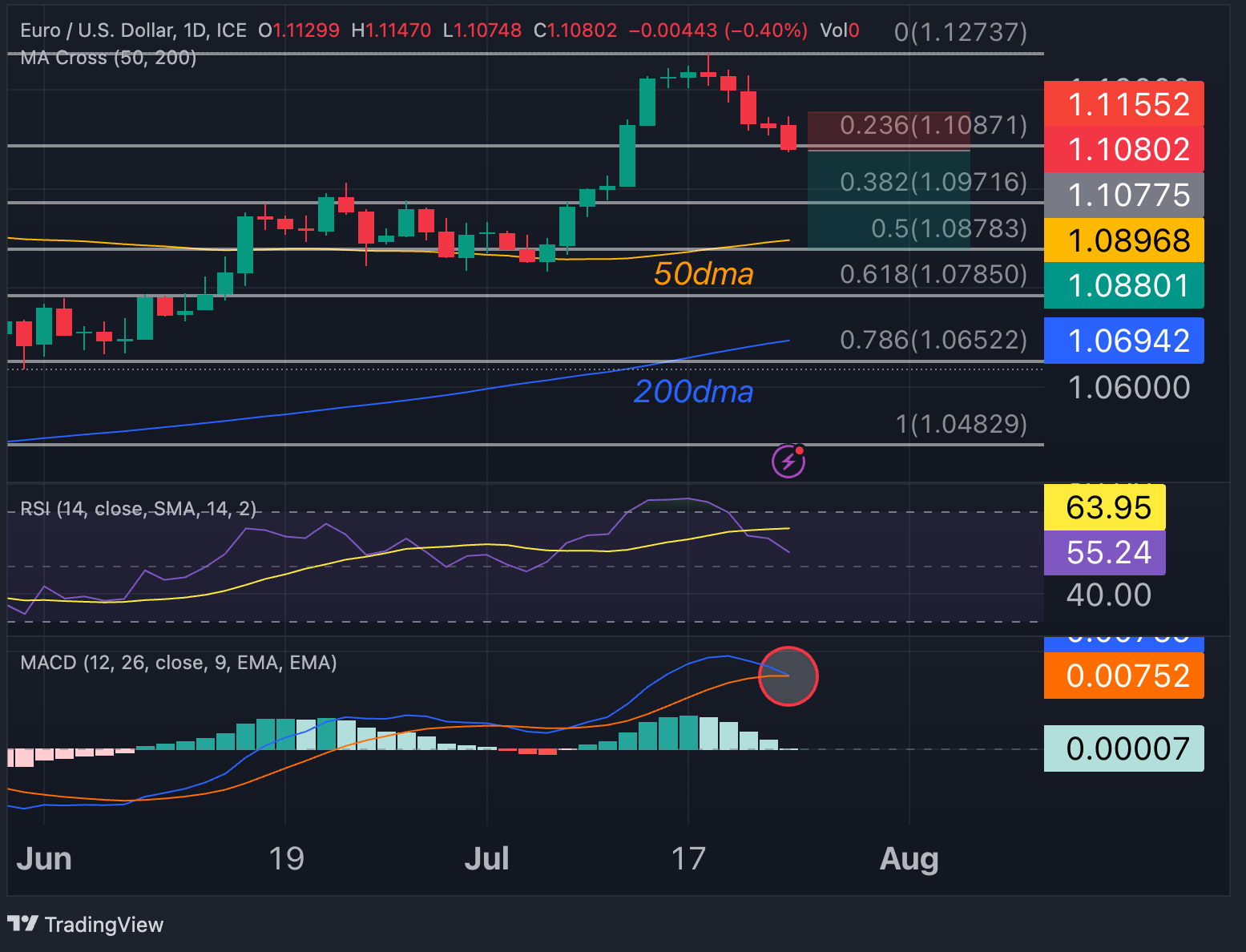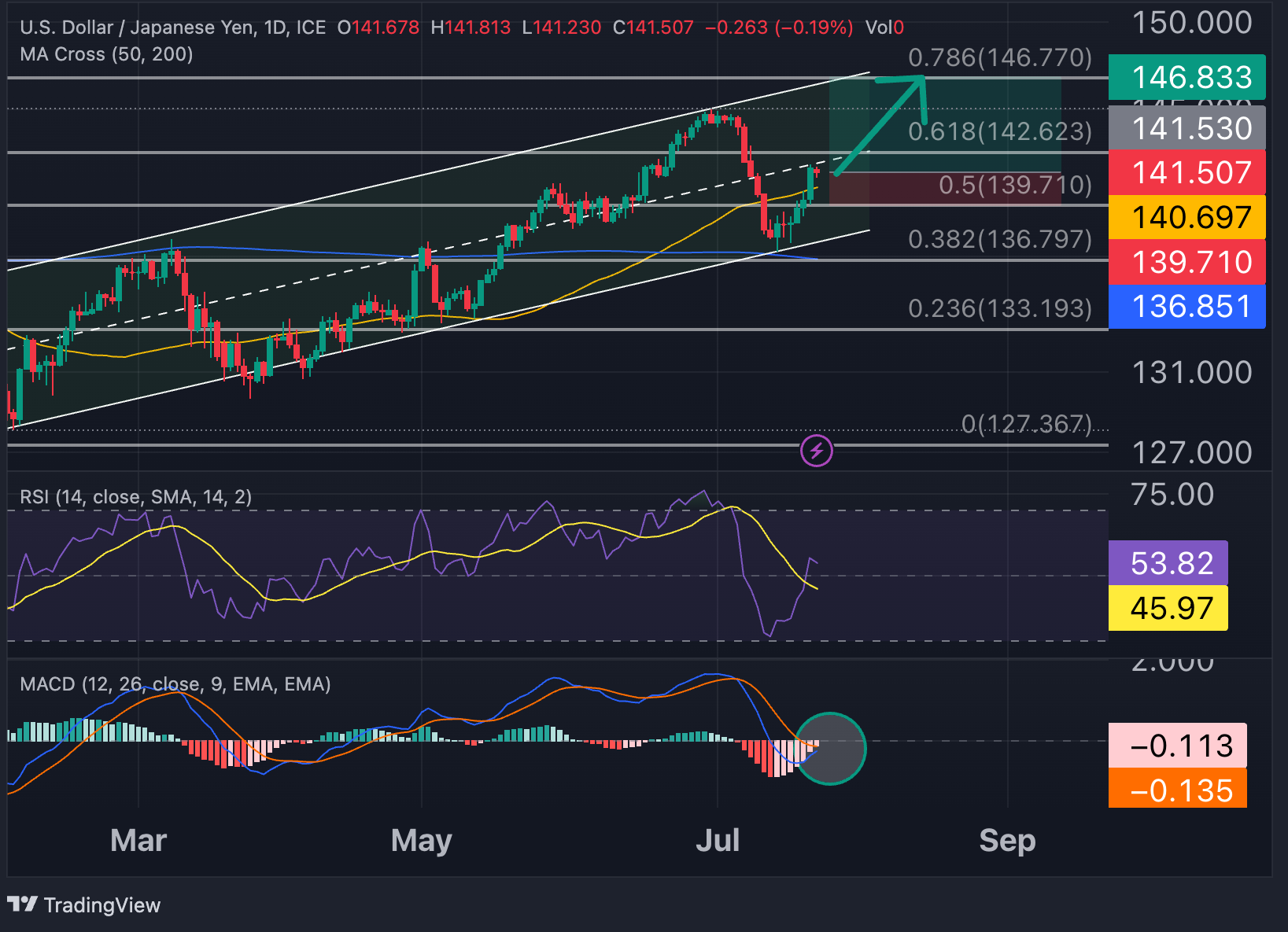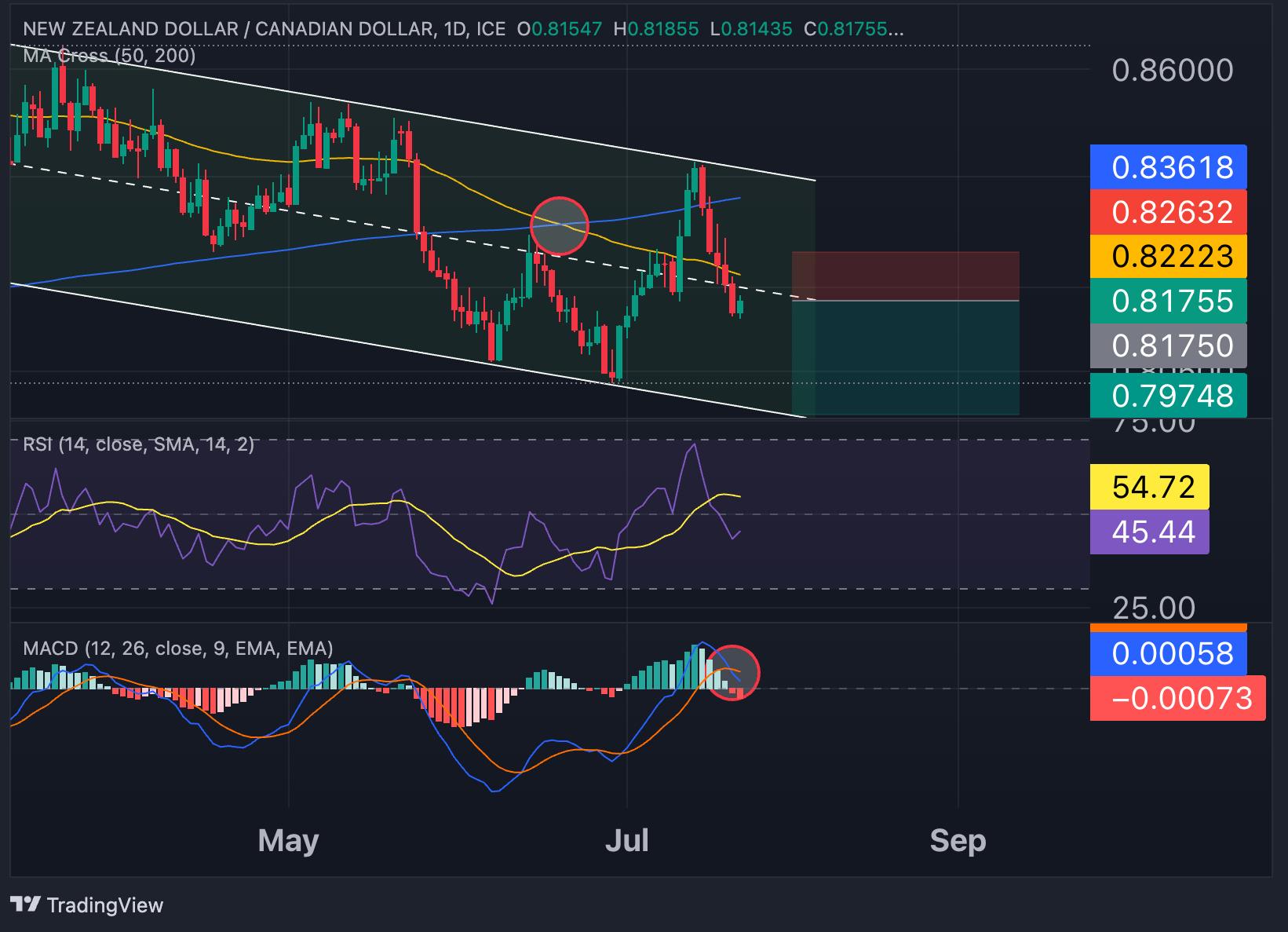Forex Trading: Central Banks in Focus - Outlook for EUR/USD, USD/JPY, NZD/CAD
Market Review: What Happened Last Week
Last week, the dollar index (DXY) rebound, surging by 1.1%, supported by significant declines in both the British pound (-1.8%) and the Japanese yen (-2.2%).
The decline in GBP was triggered by a lower-than-expected inflation rate in June. The annual CPI rate dropped to 7.9% from the previous 8.7%, falling short of the anticipated 8.2%. Additionally, the core annual rate slipped to 6.9% from the expected 7.1%.
Similarly, the JPY reacted negatively to a lower-than-expected inflation print in June. Although the annual inflation rate in Japan edged up to 3.3% in June 2023 from 3.2% in May, it remained below market forecasts of 3.5%.
The Canadian dollar (CAD) emerged as the top performer alongside the greenback. This boost was aided by a rally in energy commodities, with oil rising 2.3% for the fourth consecutive week and natural gas prices surging by 9% for the week.
On the other end of the spectrum, the New Zealand dollar (NZD) performed poorly among major currencies, losing 3% against the USD. This marked the second-worst week for the New Zealand dollar in the year so far.
At the start of the last week of July, the euro (EUR) experienced substantial weakness as it fell below 1.11 against the dollar due to disappointing Purchasing Managers' Index (PMI) readings for the Euro Area.
Looking ahead, investors are eagerly awaiting key central bank meetings, with the Federal Reserve (Fed), European Central Bank (ECB), and Bank of Japan (BoJ) in the spotlight. The market is fully anticipating a 25-basis-point hike for both the Fed and ECB meetings, while the BoJ is expected to keep rates unchanged. Additionally, other relevant economic events include PMI releases for all major economies, July's inflation rate prints for Australia and Germany, PCE inflation and Q2 GDP reading for the US.
Forex Market: Key Events Of The Week
United States:
- Fed Interest Rate Decision (Wednesday): The market fully prices in a 0.25% hike to 5.5%. The FOMC statement may leave the door open for future increases as the economy continues to perform well.
- Core PCE Price Index (Friday): Economists predict a 0.2% month-on-month rise for Fed's preferred inflation gauge in June.
- GDP Growth Rate (Q2) (Thursday): The U.S. economy is anticipated to have grown at an annualized rate of 1.7% in the second quarter.
- Durable Goods Orders (Thursday): Economists expect a 0.7% increase.
- S&P Global Manufacturing PMI Flash for July (Monday): The consensus among economists predicts a reading of 46.4, slightly up from 46.3, but still indicating deep contraction in the manufacturing sector.
- S&P Global Services PMI Flash for July (Monday): Expectations are for the service activity index to slightly drop to 54 from 54.4.
Euro Area:
- ECB Interest Rate Decision (Thursday): All the three interest rates set by the ECB are expected to be hiked by 0.25%. The door for another hike in September will likely remain open.
- Euro Area Banking Survey (Tuesday): Quarterly survey on bank lending conditions.
- Germany’s Inflation Rate for July (Friday): Economists expect a marginal drop from 6.4% to 6.2%.
Other Data to Follow:
- BoJ Interest Rate Decision (Thursday): The BoJ is expected to keep rates at -0.1%.
- Australia’s Inflation Rate (Monday): Economists predict a slowdown from 7% year-on-year in Q1 to 6.2% in Q2. June’s inflation rate is expected at 5.4% y/y.
Chart Of The Week: GBP Posts Second-Worst Week of The Year Following Its Strongest One

New Trades for The Week
Short EUR/USD: Opened at 1.1085, Take Profit 1.0880; Stop Loss 1.1150; Risk/Reward ratio at 2.54

Fundamental View
The European economy is showing initial signs of weakening, as evidenced by lower-than-expected PMIs released on Monday, and inflation is also heading towards a downward trend.
Despite the anticipated rate hike by the ECB, the need for overly aggressive action is fading. The market may start to lower its expectations for a further increase in September and consider the possibility of a first potential cut in Q1 2024. Clearly, this setup is bearish for the euro. On the other hand, the Fed is in the ideal position of having an economy that is neither too hot nor too cold. Jerome Powell is unlikely to make "dovish" comments. If the U.S. PMIs and the second-quarter GDP data reveal a healthy economic activity, the market could revise its expectations for a new hike in September or November, generating bullish pressure on the dollar.
Technical view
Monday morning's price action is sharply bearish for the EUR/USD pair, and the single currency may close its fifth consecutive session in the red. This clearly raises doubts about a retest of the mid-July highs at 1.125. The relative strength index (RSI) is pointing downward and has clearly exited an overbought position. Meanwhile, the moving-average convergence divergence (MACD) is about to provide a bearish signal as the MACD line crosses the signal line. The euro has retraced 23.6% of the range between the 2023 lows and highs and could target the interesting 50% retracement level at 1.0873, which coincides with the 50-day moving average in the very short term. Declines below 1.08 are not to be ruled out if the Fed suggests that further hikes are expected. A stop level can be set at 1.1150 (Friday's highs, July 21st).
Long USD/JPY: Opened at 141.53; Take Profit at 146.8; Stop Loss 139.71; Risk/Reward ratio at 2.91

Fundamental View
The interest-rate differential between the Fed and the BoJ is expected to widen further this week, making USD/JPY one of the most attractive carry trade pairs in the forex market. The short-term 2-year bond yield spread is heading towards 5%, a level that suppresses even the most bearish intentions on the USD/JPY pair. Despite this, USD/JPY is still trading at "cheap" levels compared to what the yield differential suggests, supporting bullish scenarios in the short term. Only a dovish Fed (which is unlikely) and an early adjustment to BoJ's yield-curve control (expected in October according to the market) could spark bearish reactions for the USD/JPY exchange rate.
Technical view
USD/JPY has been trading within an ascending channel in 2023 and has recently experienced a strong bounce after touching the lower channel line. The RSI has crossed above 50, while the MACD is attempting to provide a new bullish signal. The golden cross of the moving averages in June confirms the ongoing bullish trend. The target level around 146.8 is attractive for bulls as it represents both the channel's resistance and the 78.6% Fibonacci retracement from 2023 lows to 2022 highs. Setting a stop loss just below the 50-day moving average and slightly below the psychological level of 140 offers a risk-reward ratio of 2.9.
Short NZD/CAD: Opened at 0.8174; Take Profit at 0.7975; Stop Loss at 0.8263; Risk-reward ratio of 2.3

Fundamental View:
If this week's central bank meetings were to result in an increase in global risk aversion, it would have a greater bearish impact on the New Zealand dollar. The kiwi is highly sensitive to interest rates, while the recovery of energy commodities and the positive correlation with the US dollar are giving renewed strength to the Canadian dollar. Regarding interest rates, the Reserve Bank of New Zealand kept them steady at 5.5% in July, completing its cycle of rate hikes. On the contrary, the Bank of Canada raised rates by another 25 basis points to 5% in July and warned that further increases might be on the horizon.
Technical View:
The NZD/CAD pair experienced five consecutive red sessions last week, and the dominant trend remains bearish. This is depicted by the descending channel in place since December 2022 and the "death cross" pattern of the two moving averages that formed at the end of June. The RSI has broken below 50, while the MACD has generated a bearish crossover. The conditions seem to be in place for a test of the channel's support line below 0.80. If the bulls manage to reclaim levels above 0.8263 (Wednesday, July 19th closing price), this would invalidate the current strategy.
Trades from past weeks:
- Long USD/CHF: Opened on July 17 at 0.86; Take profit at 0.89; Stop loss at 0.85; P&L +0.9%.
- Short NZD/JPY: Opened on July 17 at 88; TP at 85; SL at 89.35; P&L +0.6%.
- Long CHF/JPY: Opened on June 19 at 158.58; TP at 171.62; SL at 152.5; P&L +2.7%.
- Long WTI spot:
Opened on May 16 at $70.8; TP $80; SL $66.3; P&L +8.8%. - Long EUR/JPY:
Opened on May 8, at 149.16, TP 160; SL 142; P&L +5.03%.
From deciphering currency pairs and mastering market analysis to implementing effective risk management strategies and choosing the right trading platforms, our guide covers it all.
Explore this invaluable guide and unlock the secrets to thriving in the dynamic landscape of forex trading, you can learn more about Your Guide to the Forex Market today.




